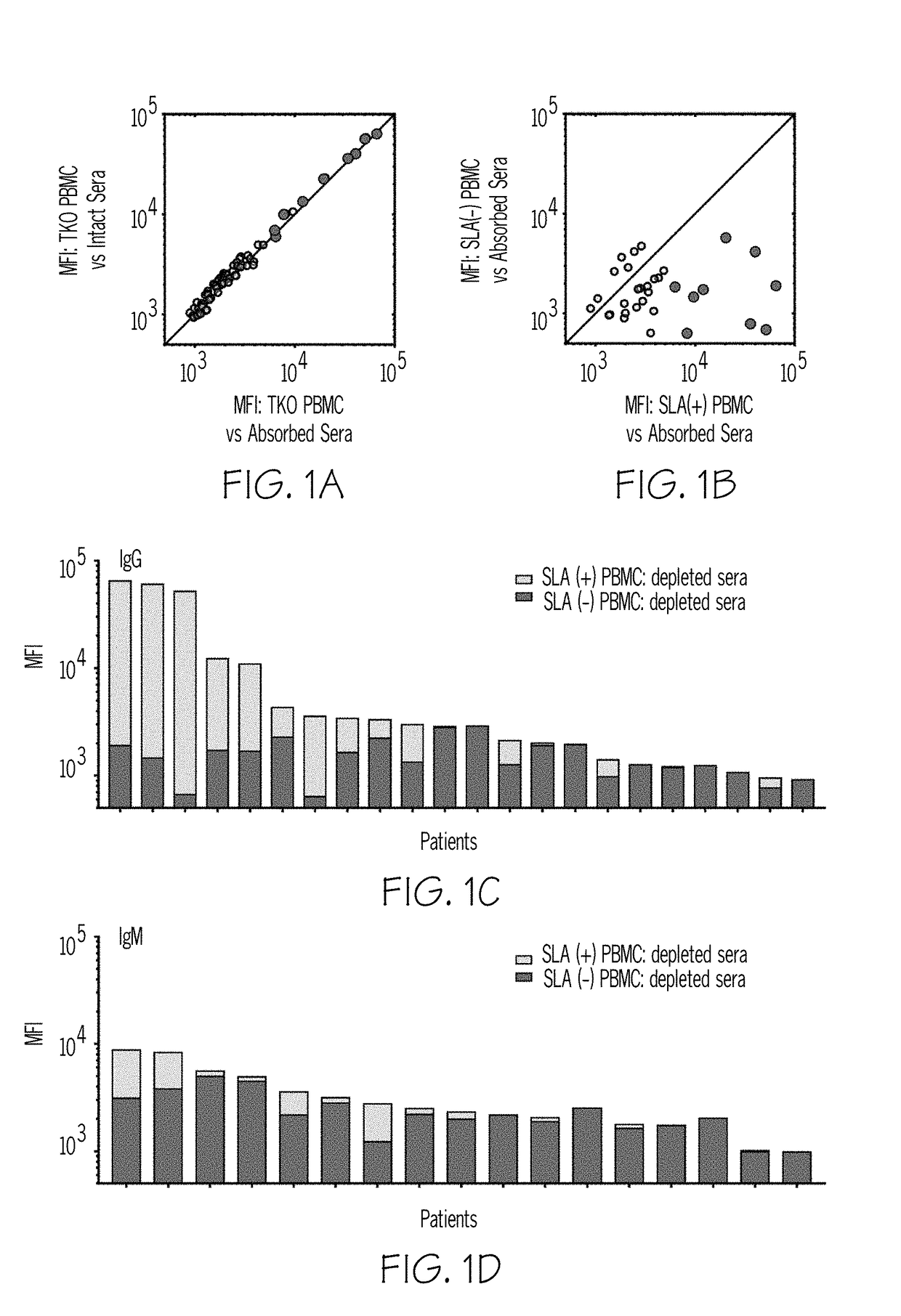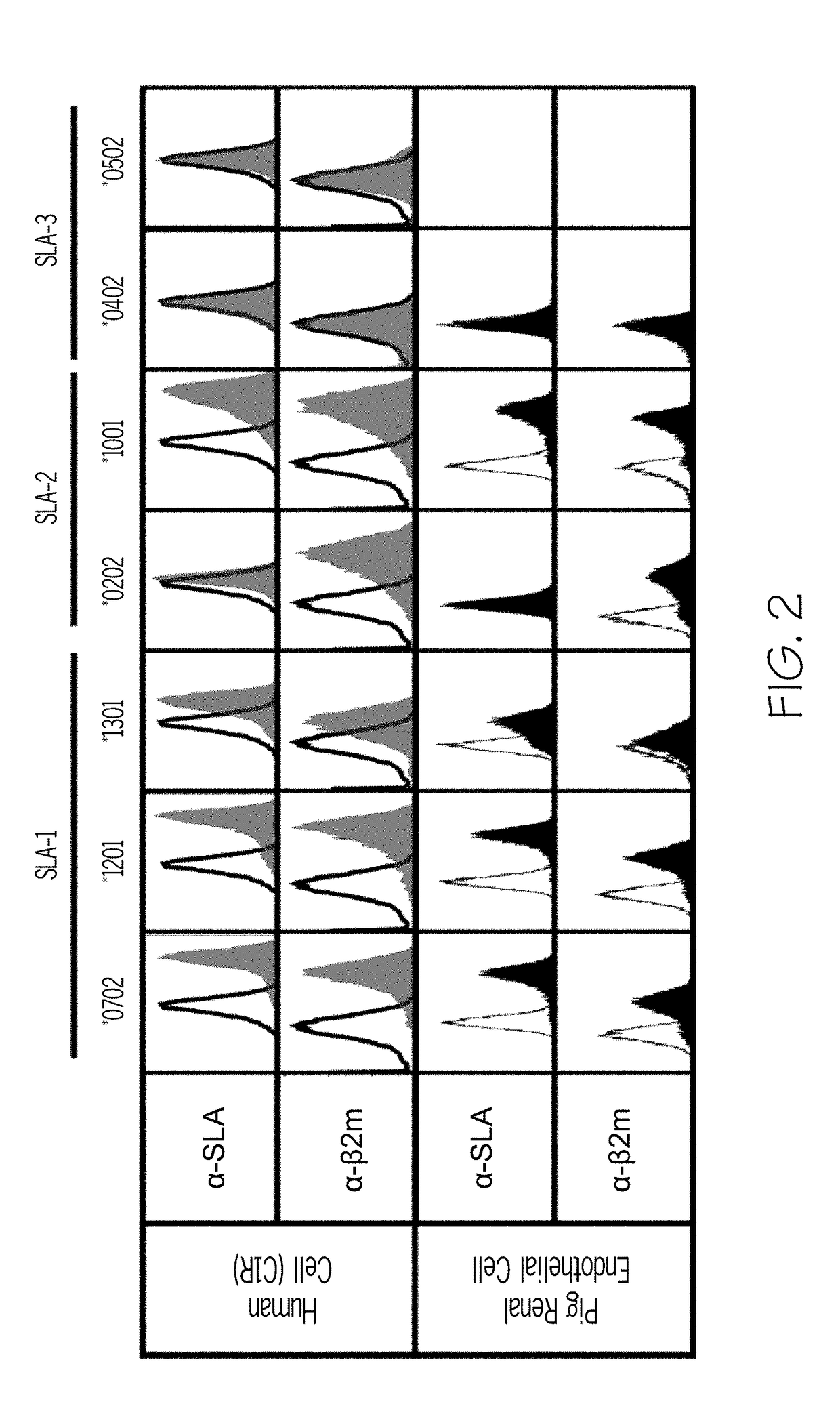Compositions and methods for detecting sla reactivity
a technology of sla and reactivity, applied in the field of detecting reactivity to antigens, can solve the problems of acute and chronic graft rejection, insufficient suitable organs for transplantation, and no system comparable to dialysis for patients with liver disease or liver failure, etc., to achieve the effect of reducing the amount of neu5gc, reducing antibody binding, and further reducing background binding
- Summary
- Abstract
- Description
- Claims
- Application Information
AI Technical Summary
Benefits of technology
Problems solved by technology
Method used
Image
Examples
example 2
n of SLA Alleles in C1R Cells
[0077]The indicated SLA alleles (SLA-1*0702, SLA-1*1201, SLA-1*1301, SLA-2*0202, SLA-2*1001, SLA-3*0402 and SLA-3*0502), were cloned into the pREP4 Mammalian Expression Vector (Invitrogen, Carlsbad Calif.). Human B-LCL (C1R) cells (unmodified), and SLA deficient pig renal endothelial cells were transfected with expression vectors comprising individual SLA-1 alleles. Stable transfectants were selected using antibiotic resistance selection; cell lines were maintained with hygromycin selection at 200 μg / mL. Transformed cells were incubated with monoclonal antibodies to either SLA or β2M to assess expression. Binding was analyzed by flow cytometry. Representative traces are shown in FIG. 2.
example 3
of Modified C1R Cell Line with Reduced Antigenicity
[0078]The B cell Fc receptor gene was also targeted. Human B-LCL (C1R) cells were modified to disrupt the CIITA, B cell Fc receptor, and IgG genes using either the Crispr-Cas9 system or gRNA. Expression of targeted genes was evaluated. The resulting cells show reduced antigenicity to human sera.
[0079]CIR (HMy2.CIR) B lymphoblast cells were obtained from ATCC (C1R, HMy2.C1R, ATCC CRL-1993). (15) Autologous Class II, low levels of Class I, B-cell IgG receptor, and Fc-Receptor expression mitigated use as a human antibody target cell. The Crispr-Cas9 system was used to modify Human B-LCL (C1R) cells. Conserved segments of heavy chains of respective molecules were targeted, Table 1, using pSpCas9(BB)-2A-GFP (PX458) which was a gift from Feng Zhang (Addgene plasmid #48138). gRNA were designed to target IgG-1, IgG-2, IgG-3 and IgG-4. gRNA were designed to target HLA-DRα, HLA-DRβ, HLA-DQβ and HLA-DPβ. gRNA were designed to the Class I HLA h...
example 4
n of SLA alleles in Modified C1R Cells
[0080]Expression vectors containing SLA alleles (as described above herein) were transformed into modified reduced antigenicity C1R cells using methods similar to those for transforming unmodified C1R cells. Stable transfectants were selected using antibody resistance. Expression of the SLA allele is analyzed by any method known in the art. Human sera were incubated with modified C1R cells expressing SLA. Binding is evaluated by flow cytometry or any other method known in the art. See for example FIGS. 15A-15D.
PUM
| Property | Measurement | Unit |
|---|---|---|
| volume | aaaaa | aaaaa |
| pH | aaaaa | aaaaa |
| pH | aaaaa | aaaaa |
Abstract
Description
Claims
Application Information
 Login to View More
Login to View More - Generate Ideas
- Intellectual Property
- Life Sciences
- Materials
- Tech Scout
- Unparalleled Data Quality
- Higher Quality Content
- 60% Fewer Hallucinations
Browse by: Latest US Patents, China's latest patents, Technical Efficacy Thesaurus, Application Domain, Technology Topic, Popular Technical Reports.
© 2025 PatSnap. All rights reserved.Legal|Privacy policy|Modern Slavery Act Transparency Statement|Sitemap|About US| Contact US: help@patsnap.com



